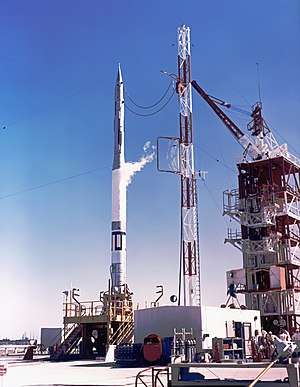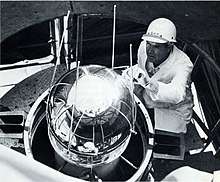Vanguard TV-5
Vanguard TV-5, also called Vanguard Test Vehicle-Five, was a failed flight of the American Vanguard rocket following the successful launch of Vanguard 1 on Vanguard TV-4. Vanguard TV-5 launched on 29 April 1958 at 02:53:00 UTC, from Launch Complex 18A at the Cape Canaveral Air Force Station. The rocket was unsuccessful in its attempt to place an unnamed satellite into orbit.[1]
 Vanguard rocket on LC-18A prior to its launch | |
| Mission type | Earth science |
|---|---|
| Operator | U.S. Navy |
| Spacecraft properties | |
| Manufacturer | Naval Research Laboratory |
| Launch mass | 9.8 kilograms (22 lb) |
| Dimensions | 51 centimetres (20 in) diameter |
| Start of mission | |
| Launch date | 29 April 1958, 02:53:00 UTC |
| Rocket | Vanguard TV-5 |
| Launch site | Cape Canaveral, LC-18A |
| Orbital parameters | |
| Reference system | Intended: Geocentric |
| Regime | Intended: Medium Earth |
Background
Project Vanguard (1955-1959) was America's first satellite program, initiated to represent the United States in the International Geophysical Year (IGY), an international effort to study the Earth's physical properties. The U.S. Navy's Naval Research Laboratory was chosen to direct the satellite project in part due to their success with the Viking (rocket) sounding rocket program. NRL was tasked with not only designing and building the satellite, also the booster that would carry it into orbit, as well as the first world-wide satellite tracking network (Minitrack).[2]
After three successful flight tests, which proved the Vanguard rocket's first stage and internal telemetry systems (TV-0 on 8 December 1956; TV-1 on 1 May 1957; TV-2 on 23 October 1957), Project Vanguard suffered two setbacks. On 6 December 1957, the first complete Vanguard rocket (TV-3), with three live stages and carrying a minimal satellite with no scientific experiments, blew up two seconds after liftoff. Two months later, on 5 February 1958, the identically configured TV-3BU broke up when a control system malfunction, after 57 seconds of normal flight, caused the Vanguard rocket to exceed a 45° angle of attack.[3]:283
On 17 March 1958, however, Vanguard 1 was successfully launched into orbit, marking the first full triumph for the project. The next step would be to launch a full-sized, instrumented Vanguard.[3]:283 For that purpose, TV-4BU, a back-up rocket identical to the TV-4 that had launched Vanguard 1, was converted to carry the larger satellite.[3]:223

Spacecraft
Vanguard TV5's satellite was a 9.75 kg (21.5 lb), 50.8 cm (20 inches) diameter sphere whose shell was composed of magnesium coated with highly polished silicon monoxide. A 108.00 MHz transmitter at 80 milliwatts was designed to provide tracking and telemetry, transmitting and receiving using four protruding metal rod antennas. Power was supplied by mercury batteries. The payload included ionization chambers sensitive to X-ray wavelengths produced in solar flares (1 to 8 Å, or 100 to 800 pm).[4]
Mission
TV-5's first stage was erected on the firing stand at Launch Complex 18A by the first week of April. However, by then, the pad managers had viewed the flight film from TV-4 and determined that the hydraulic disconnects had not separated smoothly from the rocket at liftoff. A new, pull-away firing structure was under construction, but it would not be completed for some time. As a result, modifications were made to the existing, static stand.[3]:223
These changes proved sufficient. Vanguard TV-5 launched on 29 April 1958 at 02:53:00 UTC,[3]:223 without incident. At second stage shutdown, however, a failure of a relay to engage properly prevented the arming signal from being sent to the third stage, which did not start. As a result, Vanguard TV-5 failed to achieve orbit, only reaching an altitude of 576 kilometers (358 mi).[4] This failure constituted a setback and was followed by three more launch failures in 1958.
The program achieved success in the following year with the launch of Vanguard 2 on 17 February 1959.[3]:284–285 TV-5's X-ray experiment package was successfully put into orbit on Vanguard 3, flown on Vanguard rocket SLV-7 on 18 September 1959.[5] However, the ionization chambers were completely saturated by the Van Allen Belts and returned no useful data.[6]:63 It was not until the instruments were orbited on SOLRAD 1 on 22 June 1960, a combination surveillance/science satellite designed on the Vanguard frame,[7]:300 that meaningful results were obtained.[6]:64
See also
References
- McDowell, Jonathan. "LaunchLog". Jonathon's Space Report. Retrieved April 24, 2019.
- "Vanguard Project". Naval Research Laboratory. Retrieved April 24, 2019.
- Constance Green and Milton Lomask (1970). Vanguard — a History. Washington D.C.: National Aeronautics and Space Administration. ISBN 978-1-97353-209-5. SP-4202.
- "Vanguard TV5". NASA Space Science Data Coordinated Archive. Retrieved April 24, 2019.
- "NASA, X-Ray Experiment, Vanguard 3". NASA. Retrieved April 24, 2019.
- Significant Achievements in Solar Physics 1958–1964. Washington D.C.: NASA. 1966. OCLC 860060668.
- American Astronautical Society (August 23, 2010). Space Exploration and Humanity: A Historical Encyclopedia [2 volumes]: A Historical Encyclopedia. Santa Barbara, Calif: ABC-CLIO. ISBN 978-1-85109-519-3.
Further reading
- Mallove, Eugene F. and Matloff, Gregory L. The Starflight Handbook: A Pioneer's Guide to Interstellar Travel, Wiley. ISBN 0-471-61912-4.